Thalheim, Aargau
Thalheim is a municipality in the district of Brugg in the canton of Aargau in Switzerland.
Thalheim | |
|---|---|
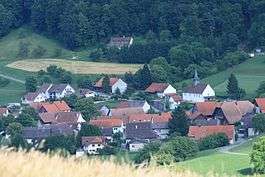 | |
 Coat of arms | |
Location of Thalheim 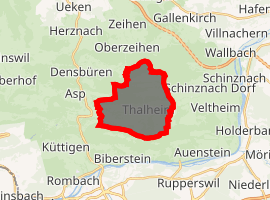
| |
 Thalheim 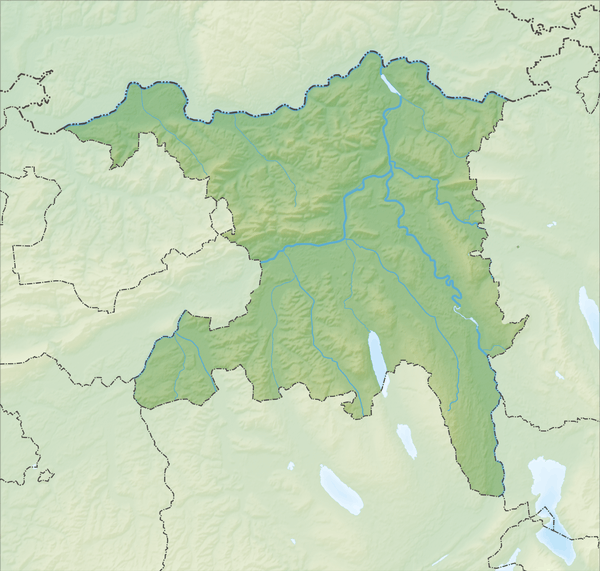 Thalheim | |
| Coordinates: 47°26′N 8°6′E | |
| Country | Switzerland |
| Canton | Aargau |
| District | Brugg |
| Area | |
| • Total | 9.92 km2 (3.83 sq mi) |
| Elevation | 451 m (1,480 ft) |
| Population (2018-12-31)[2] | |
| • Total | 831 |
| • Density | 84/km2 (220/sq mi) |
| Postal code | 5112 |
| SFOS number | 4117 |
| Surrounded by | Auenstein, Biberstein, Densbüren, Küttigen, Oberflachs, Schinznach-Dorf, Zeihen |
| Website | www SFSO statistics |
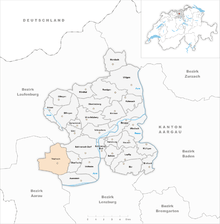
Geography
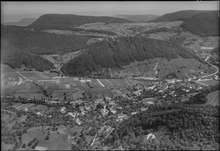
Thalheim has an area, as of 2009, of 9.91 square kilometers (3.83 sq mi). Of this area, 4.95 square kilometers (1.91 sq mi) or 49.9% is used for agricultural purposes, while 4.31 square kilometers (1.66 sq mi) or 43.5% is forested. Of the rest of the land, 0.57 square kilometers (0.22 sq mi) or 5.8% is settled (buildings or roads), 0.01 km2 (2.5 acres) or 0.1% is either rivers or lakes.[3]
Of the built up area, housing and buildings made up 2.4% and transportation infrastructure made up 2.7%. 40.1% of the total land area is heavily forested and 3.4% is covered with orchards or small clusters of trees. Of the agricultural land, 17.9% is used for growing crops and 29.7% is pastures, while 2.4% is used for orchards or vine crops. All the water in the municipality is in rivers and streams.[3]
Coat of arms
The blazon of the municipal coat of arms is Argent a Grape Azure slipped and leaved Vert.[4]
Demographics
Thalheim has a population (as of December 2018) of 831[5] As of June 2009, 4.7% of the population are foreign nationals.[6] Over the last 10 years (1997–2007) the population has changed at a rate of -6.3%. Most of the population (as of 2000) speaks German (98.5%), with Italian being second most common ( 0.4%) and Portuguese being third ( 0.3%).[7]
The age distribution, as of 2008, in Thalheim is; 58 children or 7.8% of the population are between 0 and 9 years old and 100 teenagers or 13.5% are between 10 and 19. Of the adult population, 80 people or 10.8% of the population are between 20 and 29 years old. 68 people or 9.2% are between 30 and 39, 138 people or 18.7% are between 40 and 49, and 117 people or 15.8% are between 50 and 59. The senior population distribution is 92 people or 12.4% of the population are between 60 and 69 years old, 53 people or 7.2% are between 70 and 79, there are 30 people or 4.1% who are between 80 and 89,and there are 3 people or 0.4% who are 90 and older.[8]
As of 2000, there were 32 homes with 1 or 2 persons in the household, 120 homes with 3 or 4 persons in the household, and 127 homes with 5 or more persons in the household. The average number of people per household was 2.61 individuals.[9] As of 2000, there were 285 private households (homes and apartments) in the municipality, and an average of 2.6 persons per household.[7] In 2008 there were 143 single family homes (or 44.1% of the total) out of a total of 324 homes and apartments.[10] There were a total of 0 empty apartments for a 0.0% vacancy rate.[10] As of 2007, the construction rate of new housing units was 1.4 new units per 1000 residents.[7]
In the 2007 federal election the most popular party was the SVP which received 54.6% of the vote. The next three most popular parties were the SP (12.3%), the CVP (7.8%) and the FDP (7.7%).[7]
In Thalheim about 74.9% of the population (between age 25-64) have completed either non-mandatory upper secondary education or additional higher education (either university or a Fachhochschule).[7] Of the school age population (in the 2008/2009 school year), there are 46 students attending primary school in the municipality.[9]
The historical population is given in the following table:[8]
| Year | Pop. | ±% |
|---|---|---|
| 1975 | 551 | — |
| 1980 | 565 | +2.5% |
| 1990 | 645 | +14.2% |
| 2000 | 758 | +17.5% |
Heritage sites of national significance
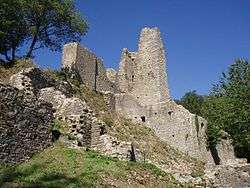
The ruins of Schenkenberg castle are listed as a Swiss heritage site of national significance.[11]
The village of Thalheim is designated as part of the Inventory of Swiss Heritage Sites.[12]
Economy
As of 2007, Thalheim had an unemployment rate of 0.67%. As of 2005, there were 61 people employed in the primary economic sector and about 29 businesses involved in this sector. 64 people are employed in the secondary sector and there are 7 businesses in this sector. 81 people are employed in the tertiary sector, with 21 businesses in this sector.[7]
As of 2000 there was a total of 394 workers who lived in the municipality. Of these, 284 or about 72.1% of the residents worked outside Thalheim while 92 people commuted into the municipality for work. There were a total of 202 jobs (of at least 6 hours per week) in the municipality.[13] Of the working population, 7.8% used public transportation to get to work, and 65% used a private car.[7]
Religion
From the 2000 census, 94 or 12.6% were Roman Catholic, while 570 or 76.6% belonged to the Swiss Reformed Church. Of the rest of the population, there was 1 individual who belonged to the Christian Catholic faith.[9]
References
- "Arealstatistik Standard - Gemeinden nach 4 Hauptbereichen". Federal Statistical Office. Retrieved 13 January 2019.
- "Ständige Wohnbevölkerung nach Staatsangehörigkeitskategorie Geschlecht und Gemeinde; Provisorische Jahresergebnisse; 2018". Federal Statistical Office. 9 April 2019. Retrieved 11 April 2019.
- Swiss Federal Statistical Office-Land Use Statistics 2009 data (in German) accessed 25 March 2010
- Flags of the World.com accessed 9 April 2010
- Swiss Federal Statistical Office - STAT-TAB, online database – Ständige und nichtständige Wohnbevölkerung nach institutionellen Gliederungen, Geburtsort und Staatsangehörigkeit (in German) accessed 23 September 2019
- Statistical Department of Canton Aargau -Bereich 01 -Bevölkerung (in German) accessed 20 January 2010
- Swiss Federal Statistical Office accessed 9 April 2010
- Statistical Department of Canton Aargau -Bevölkerungsdaten für den Kanton Aargau und die Gemeinden (Archiv) (in German) accessed 20 January 2010
- Statistical Department of Canton Aargau - Aargauer Zahlen 2009 (in German) accessed 20 January 2010
- Statistical Department of Canton Aargau (in German) accessed 20 January 2010
- Swiss inventory of cultural property of national and regional significance Archived 1 May 2009 at the Wayback Machine 21.11.2008 version, (in German) accessed 09-Apr-2010
- ISOS site accessed 09-Apr-2010
- Statistical Department of Canton Aargau-Bereich 11 Verkehr und Nachrichtenwesen (in German) accessed 21 January 2010
| Wikimedia Commons has media related to Thalheim AG. |